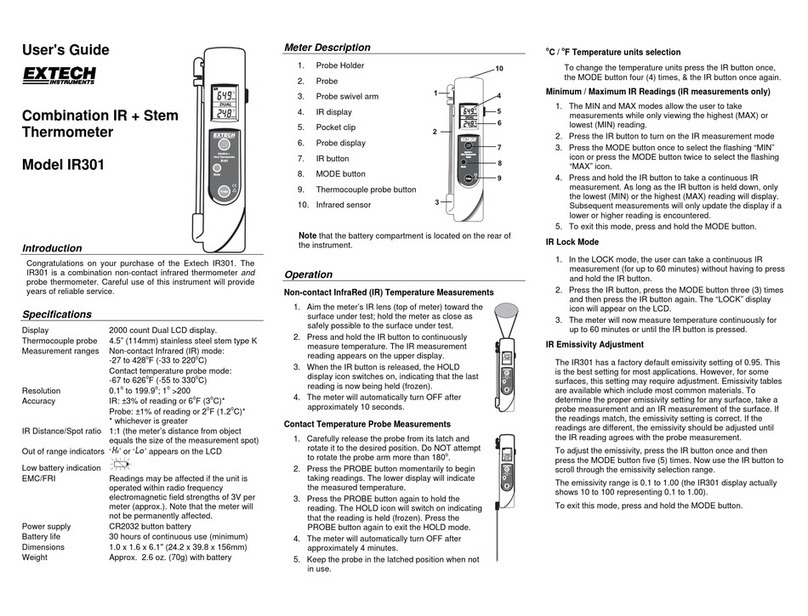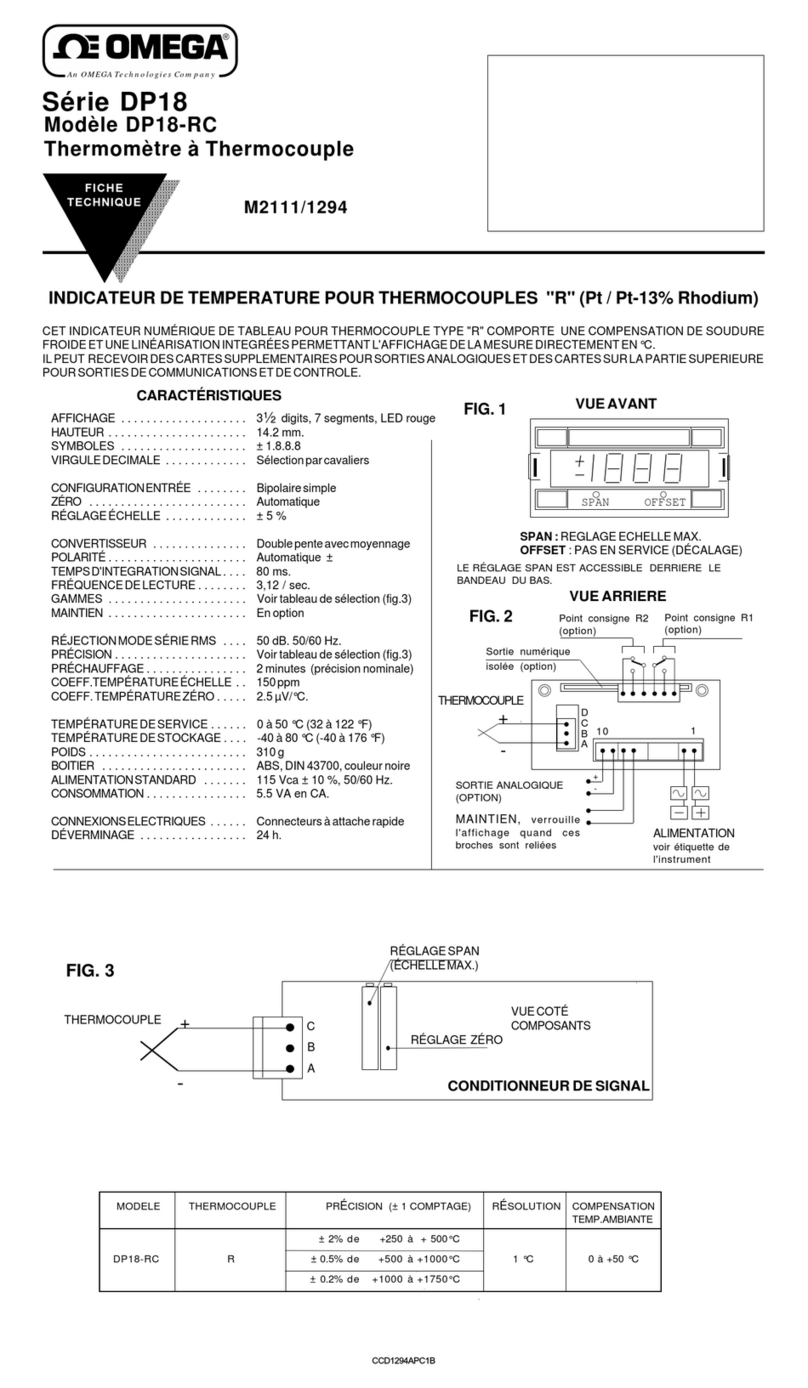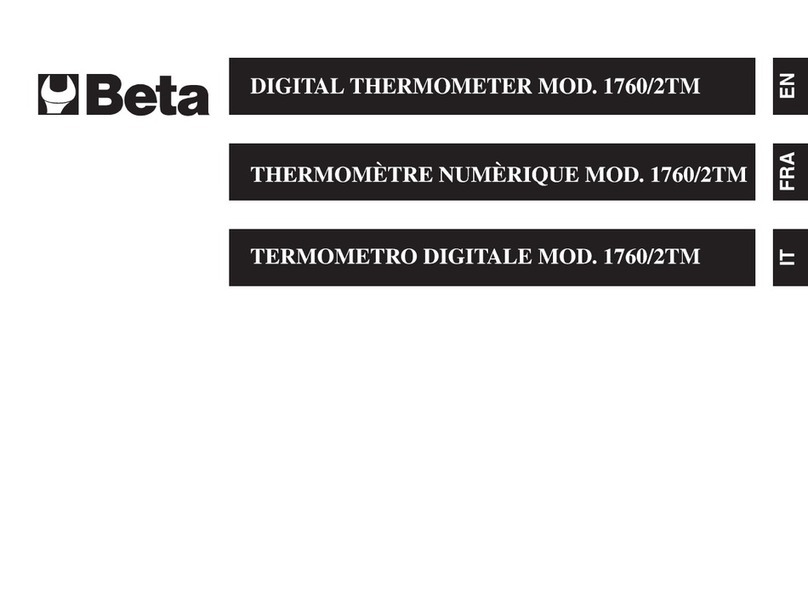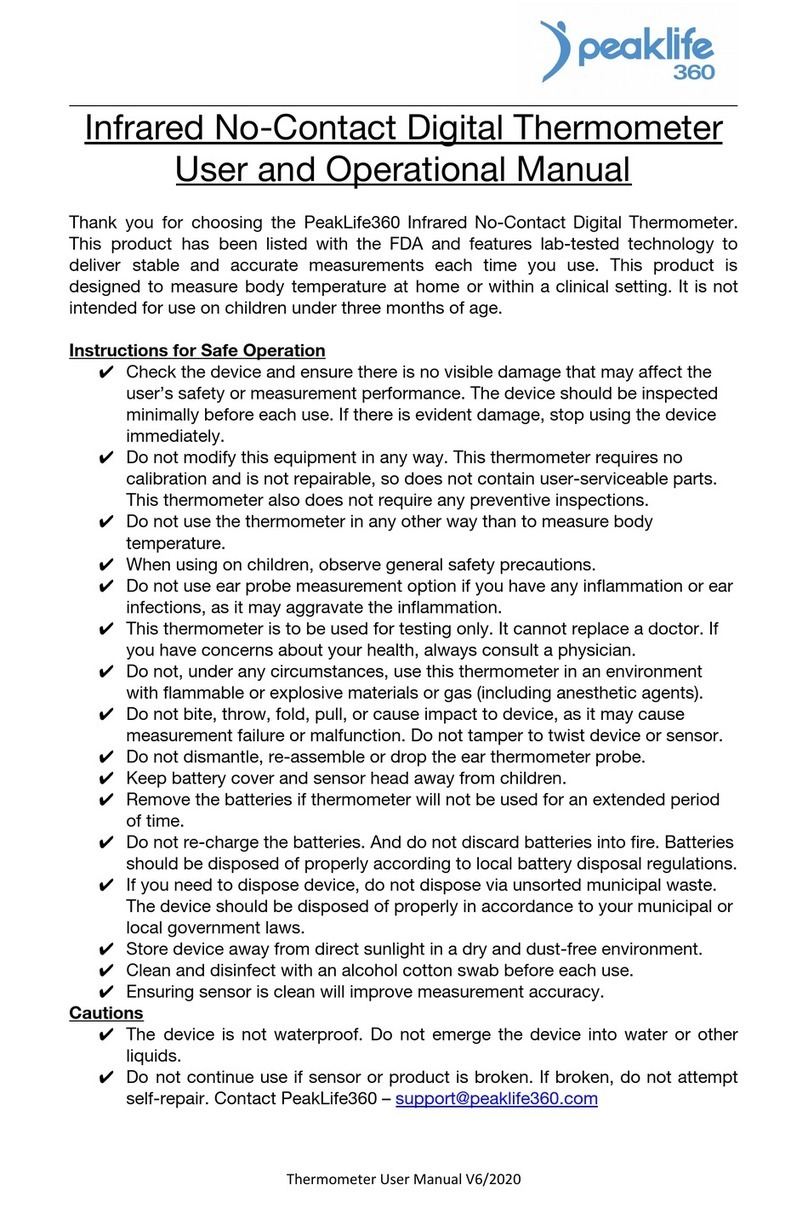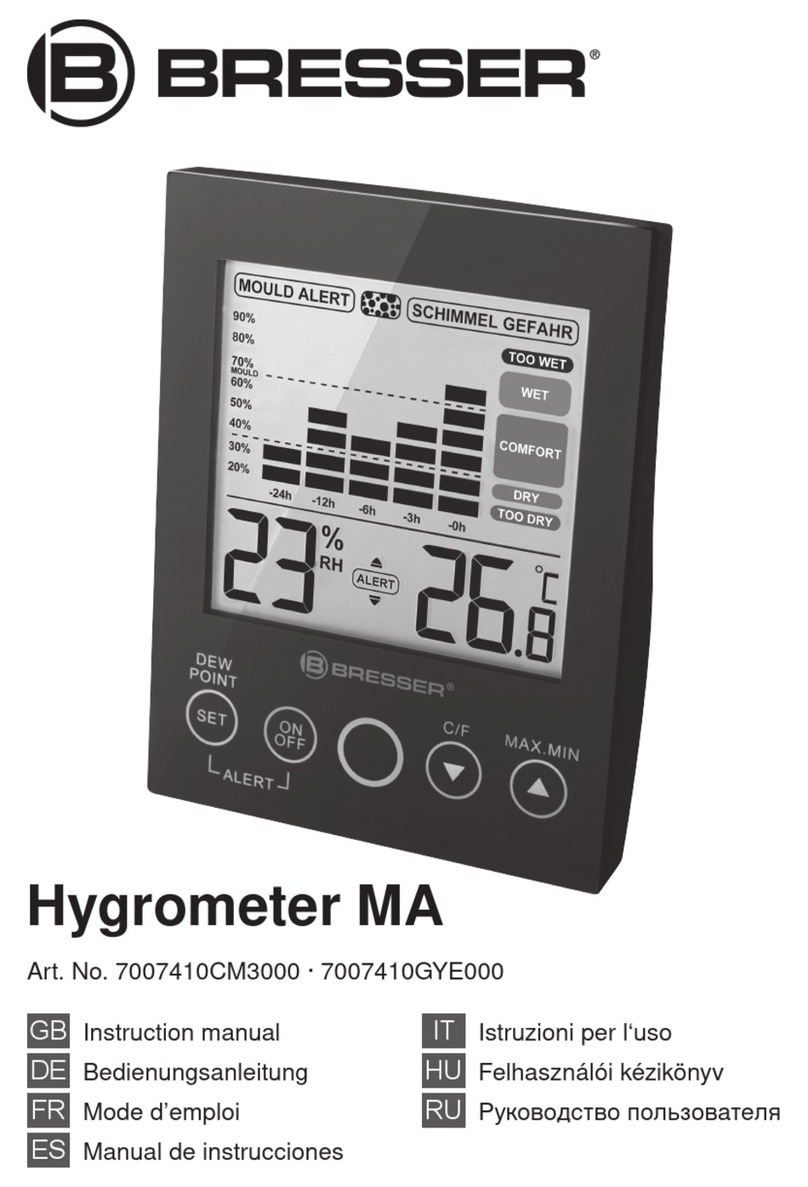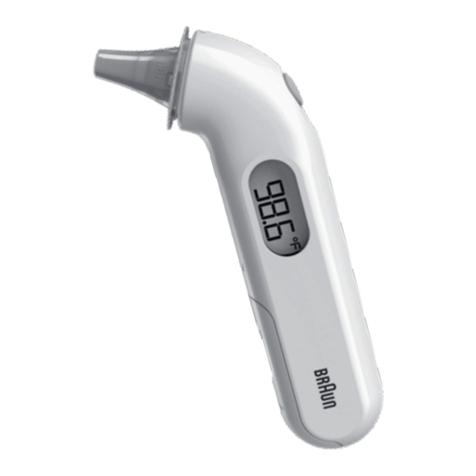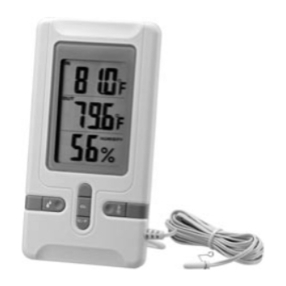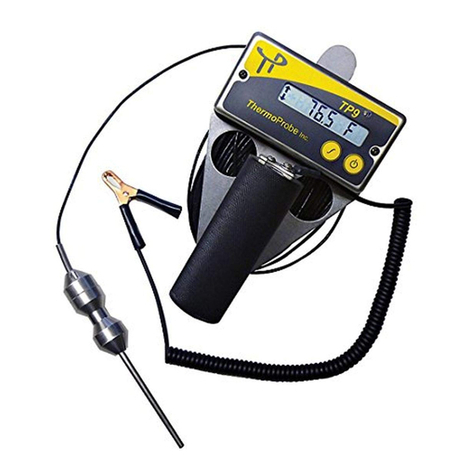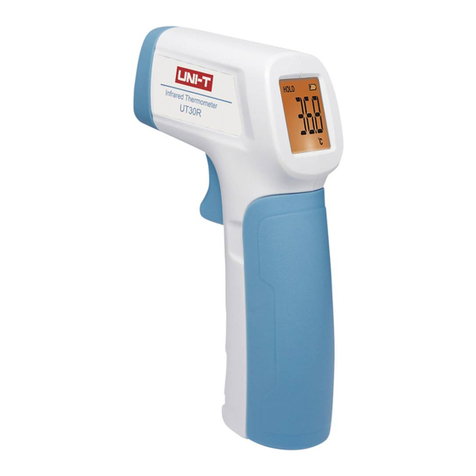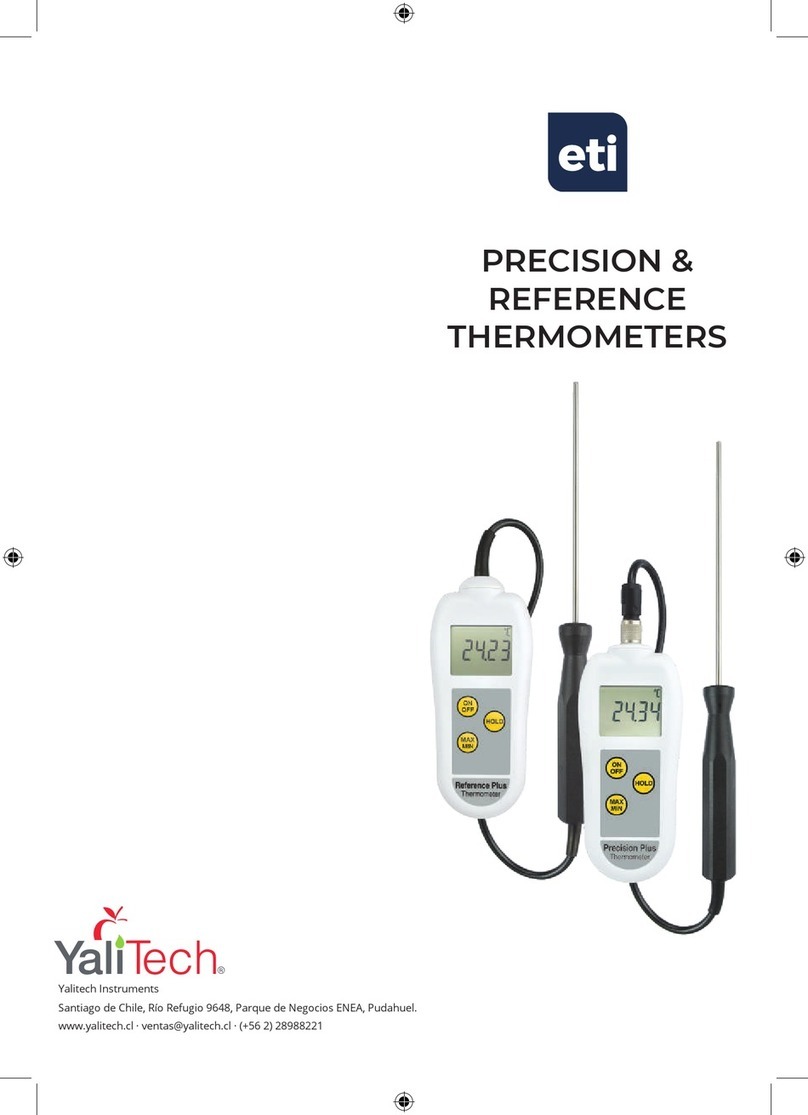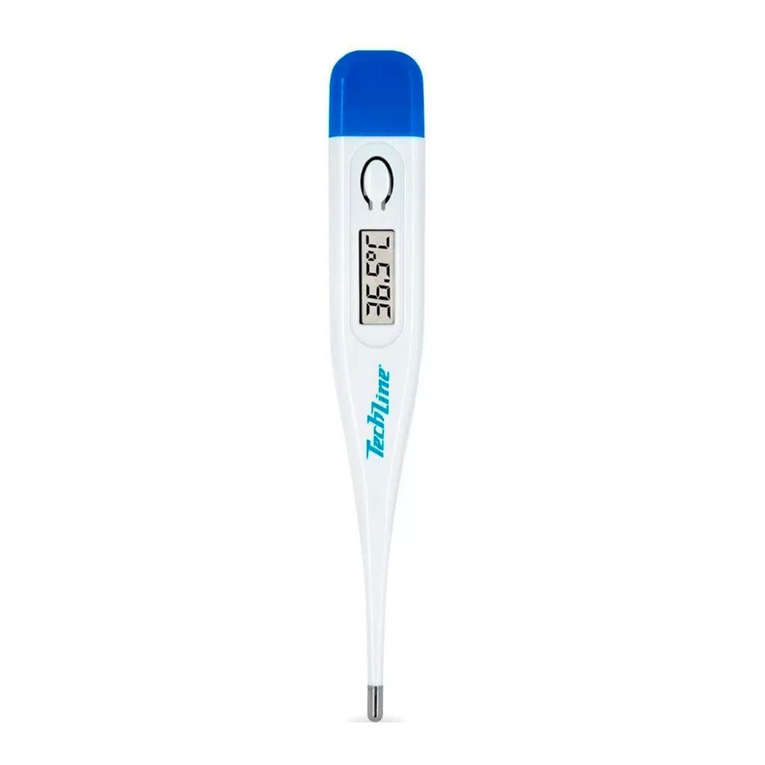Ecco Pacific 111 User manual

OPERATING INSTRUCTIONS
MODEL: 111
INFRARED THERMOMETER
WITH LASER SIGHTING
INTRODUCTION
This instrument is a portable easy to use 3½digit, com-
pact-sized digital infrared thermometer with laser sighting
designed for simple one hand operation. Meter comes with
backlight LCD display, Auto-Hold function and Auto
Power Off (10 seconds approx.) to extend battery life.
SAFETY INFORMATION
It is recommended that users read the safety and opera-
tion instructions before using the infrared thermometer.
DANGER
When sign appears, pull the trigger to turn the laser
beam on and off.
Be very cautious with the laser beam, not aiming your
eyes or those of any other person or animal.
●Do not look directly into the laser light from the opti-
cal system.
●When measuring the temperature of an object which
has a mirror finish, be careful not to allow the laser
light beam to be reflected off the surface into your
eyes or those of another person.
●Do not allow the laser light beam to impinge upon any
gas which can explode.
CAUTION
●Do not use the unit near any device which generates
strong electromagnetic radiation or near a static elec-
trical charge, as these may cause errors.
●Do not use the unit where it may be exposed to corro-
sive or explosive gases. The unit may be damaged, or
explosion may occur.
●Do not keep or use this unit in an environment where
it will be directly illuminated by sunshine, or where it
condensation. If you do, it may be deformed, its insu-
lation may be damaged, or it may no longer function
according to specification.
●Do not place the meter on or around hot objects
(70°C/158°F). It may cause damage to the case.
●If the meter is exposed to significant changes in ambi-
ent temperature (hot to cold or cold to hot). Allow 30
minutes for temperature stabilization, before taking
measurement.
●Condensation may form on the sensor when going
from a cold to hot environment-wait 10 minutes for
condensation to dissipate before taking measurements.
●This unit is not constructed to be waterproof or dust
proof, so do not use it in a very dusty environment or
in one where it will get wet.
●Do not point the lens at the sun or at any other
source of strong light. If you do, the sensor may be
damaged.
●Do not contact the lens against the object whose
temperature is to be measured, or get it dirty, allow
it to be scratched, or allow any foreign material to
adhere to it. Doing so may cause errors.
●Do not touch or hold by the front case. Tempera-
ture reading can be affected by heat from hand.
●Readings may be affected if the unit is operated
within a radio frequency electromagnetic field
strength of approximately 9 volts per meter, but
the performance of the instrument will not be per-
manently affected.
SPECIFICATIONS
GENERAL
Display: 3½ digit liquid crystal display (LCD) with maxi-
mum reading of 1999.
Low battery indication: The “ ” is displayed when the
battery voltage drops below the operating level.
Measurement rate: 0.25 second per measurement.
Operating Environment: 32°F to 122°F (0°C to 50°C) at
< 70% R.H.
Storage Temperature: -4°F to 140°F (-20°C to 60°C), 0
to 80% R.H. with battery removed from meter.
Auto power off: 10 seconds.
Standby consuming current: <5µA.
Battery: Standard 9V battery (NEDA 1604, IEC 6F22
006P).
Battery Life: 9 hours (continuity) typical.
(contain Laser and Backlit)
Dimensions: 148mm(H) x 105mm(W) x 42mm(D).
Weight: approx. 157g. (including battery)
Laser Specifications
Laser safety classification of Class 2.
Wave Length: Red (630~670nm).
Power out: <1mW, class 2 laser product.
ELECTRICAL
Temperature Range: -30°C to 550°C / -22°F to 1022°F.
Display Resolution: 0.5/1°C (Auto), 1°F.
Accuracy:
±(2°C/4°F) for -30°C to 100°C, -22°F to 212°F.
±(2% reading) for 101°C to 550°C, 213°F to 1022°F.
Temperature Coefficient:
±0.2% of reading or ±0.36°F/0.2°C, whichever is
greater, change in accuracy per °F/°C change in ambient
operating temperature above 82.4°F/28°C or below
64.4°F/18°C.
Response Time: 0.25 second
Spectral Response: 6 to 14µm
Adjustable emissivity (ε): 0.1 to 1.0.
Detection Element: Thermopile.
Optical Lens: Fresnel Lens.
Sighting: 1-beam laser marker <1mW (class 2).
Field of View: 100mmØ at 1000mm (3.9"Ø at 39.0").
Spot size increases with distance from the probe tip as shown
(Spot Diameter measured at 90 % Energy)
DEFINITION
FUNCTION KEY
SET key
Press “SET” key goes to the setting mode. Use the same
key to go to next step, following as the cycle : ε → ALM
Hi →ALM Lo →MAX →MIN →measuring mode.
key
Press key, LCD shows “ ” sign. Then pull the trig-
ger to turn on laser pointing function to aim at the measur-
ing point of object. Repeat same steps turns off laser point-
ing function.
key
Use key to turn on or off the Back-Light function.
°C/°F key
Use the °C/°F key to select reading displayed in Cel-
sius(°C) or Fahrenheit(°F).
APO key
The meter is default to APO (auto power off) activated
along with manual mode. Leave the meter without opera-
tion for 10 seconds, power turns off automatically.
Press “APO” key to disable APO function and will go to
auto continuous mode. Continuous measuring will be
performed without holding the trigger. Press “APO” key
again to return to APO activated along with manual mode.
▲and ▼key
Use ▲or ▼to adjust ε, ALM Hi, and ALM Lo in
setting mode. Hold the key will speed up.
Customer Care Australia P: 13122 F: 1300 303 310 E: sales@cabac.com.au W:cabac.com.au
A: Distribution Pl, Seven Hills NSW 2147
Customer Care New Zealand P: 0800 966 969 F: 0088 6969 E: sales@cabac.co.nz W: cabac.co.nz
1

OPERATING INSTRUCTIONS
MODEL: 111
INFRARED THERMOMETER
WITH LASER SIGHTING
INTRODUCTION
This instrument is a portable easy to use 3½digit, com-
pact-sized digital infrared thermometer with laser sighting
designed for simple one hand operation. Meter comes with
backlight LCD display, Auto-Hold function and Auto
Power Off (10 seconds approx.) to extend battery life.
SAFETY INFORMATION
It is recommended that users read the safety and opera-
tion instructions before using the infrared thermometer.
DANGER
When sign appears, pull the trigger to turn the laser
beam on and off.
Be very cautious with the laser beam, not aiming your
eyes or those of any other person or animal.
●Do not look directly into the laser light from the opti-
cal system.
●When measuring the temperature of an object which
has a mirror finish, be careful not to allow the laser
light beam to be reflected off the surface into your
eyes or those of another person.
●Do not allow the laser light beam to impinge upon any
gas which can explode.
CAUTION
●Do not use the unit near any device which generates
strong electromagnetic radiation or near a static elec-
trical charge, as these may cause errors.
●Do not use the unit where it may be exposed to corro-
sive or explosive gases. The unit may be damaged, or
explosion may occur.
●Do not keep or use this unit in an environment where
it will be directly illuminated by sunshine, or where it
condensation. If you do, it may be deformed, its insu-
lation may be damaged, or it may no longer function
according to specification.
●Do not place the meter on or around hot objects
(70°C/158°F). It may cause damage to the case.
●If the meter is exposed to significant changes in ambi-
ent temperature (hot to cold or cold to hot). Allow 30
minutes for temperature stabilization, before taking
measurement.
●Condensation may form on the sensor when going
from a cold to hot environment-wait 10 minutes for
condensation to dissipate before taking measurements.
●This unit is not constructed to be waterproof or dust
proof, so do not use it in a very dusty environment or
in one where it will get wet.
●Do not point the lens at the sun or at any other
source of strong light. If you do, the sensor may be
damaged.
●Do not contact the lens against the object whose
temperature is to be measured, or get it dirty, allow
it to be scratched, or allow any foreign material to
adhere to it. Doing so may cause errors.
●Do not touch or hold by the front case. Tempera-
ture reading can be affected by heat from hand.
●Readings may be affected if the unit is operated
within a radio frequency electromagnetic field
strength of approximately 9 volts per meter, but
the performance of the instrument will not be per-
manently affected.
SPECIFICATIONS
GENERAL
Display: 3½ digit liquid crystal display (LCD) with maxi-
mum reading of 1999.
Low battery indication: The “ ” is displayed when the
battery voltage drops below the operating level.
Measurement rate: 0.25 second per measurement.
Operating Environment: 32°F to 122°F (0°C to 50°C) at
< 70% R.H.
Storage Temperature: -4°F to 140°F (-20°C to 60°C), 0
to 80% R.H. with battery removed from meter.
Auto power off: 10 seconds.
Standby consuming current: <5µA.
Battery: Standard 9V battery (NEDA 1604, IEC 6F22
006P).
Battery Life: 9 hours (continuity) typical.
(contain Laser and Backlit)
Dimensions: 148mm(H) x 105mm(W) x 42mm(D).
Weight: approx. 157g. (including battery)
Laser Specifications
Laser safety classification of Class 2.
Wave Length: Red (630~670nm).
Power out: <1mW, class 2 laser product.
ELECTRICAL
Temperature Range: -30°C to 550°C / -22°F to 1022°F.
Display Resolution: 0.5/1°C (Auto), 1°F.
Accuracy:
±(2°C/4°F) for -30°C to 100°C, -22°F to 212°F.
±(2% reading) for 101°C to 550°C, 213°F to 1022°F.
Temperature Coefficient:
±0.2% of reading or ±0.36°F/0.2°C, whichever is
greater, change in accuracy per °F/°C change in ambient
operating temperature above 82.4°F/28°C or below
64.4°F/18°C.
Response Time: 0.25 second
Spectral Response: 6 to 14µm
Adjustable emissivity (ε): 0.1 to 1.0.
Detection Element: Thermopile.
Optical Lens: Fresnel Lens.
Sighting: 1-beam laser marker <1mW (class 2).
Field of View: 100mmØ at 1000mm (3.9"Ø at 39.0").
Spot size increases with distance from the probe tip as shown
(Spot Diameter measured at 90 % Energy)
DEFINITION
FUNCTION KEY
SET key
Press “SET” key goes to the setting mode. Use the same
key to go to next step, following as the cycle : ε → ALM
Hi →ALM Lo →MAX →MIN →measuring mode.
key
Press key, LCD shows “ ” sign. Then pull the trig-
ger to turn on laser pointing function to aim at the measur-
ing point of object. Repeat same steps turns off laser point-
ing function.
key
Use key to turn on or off the Back-Light function.
°C/°F key
Use the °C/°F key to select reading displayed in Cel-
sius(°C) or Fahrenheit(°F).
APO key
The meter is default to APO (auto power off) activated
along with manual mode. Leave the meter without opera-
tion for 10 seconds, power turns off automatically.
Press “APO” key to disable APO function and will go to
auto continuous mode. Continuous measuring will be
performed without holding the trigger. Press “APO” key
again to return to APO activated along with manual mode.
▲and ▼key
Use ▲or ▼to adjust ε, ALM Hi, and ALM Lo in
setting mode. Hold the key will speed up.
Customer Care Australia P: 13122 F: 1300 303 310 E: sales@cabac.com.au W:cabac.com.au
A: Distribution Pl, Seven Hills NSW 2147
Customer Care New Zealand P: 0800 966 969 F: 0088 6969 E: sales@cabac.co.nz W: cabac.co.nz
2

OPERATING INSTRUCTIONS
Power on and off:
1. Pull the trigger to turn on power. The LCD shows read-
ings from last measurement.
2. Auto Power Off (APO) function: Leave the meter with-
out operation for 10 seconds, power turns off automati-
cally.
Manual Single and Continuous Mode:
1. The meter is default to manual mode. Pull the trigger to
turn on power. Aim at the object, and quickly pull the
trigger to measure. When the LCD shows readings and
“HOLD” sign, single measurement is completed. Leave
the meter without operation for 10 seconds, power turns
off automatically.
2. Hold the trigger to measure continuously. Reading
changes every 0.25 second until the trigger is released.
At the mean time, LCD shows last reading and “HOLD”
sign.
Auto Continuous Mode:
The meter is default to manual mode. Press “APO” key.
Auto power off function will be cancelled, and auto con-
tinuous mode is activated. No need to hold the trigger, the
meter measures automatically. LCD will not show
“HOLD” sign and reading changes every 0.25 second
Press “APO” key again returns to manual mode.
Emissivity, Hi/Lo Limit Setting and MAX/MIN:
Power on. Press “SET” key to enter setting mode and use
the same key to go to next step, following as the cycle:
ε: Emissivity; Use ▲or ▼
to adjust. (Table 1)
ALM Hi : High Limit Alarm Function:
Use ▲or ▼to adjust.
When reading is higher than
setting, beeper makes brief
beeping sound, and LCD shows “ALM Hi”
sign.
ALM Lo : Low Limit Alarm Function: Use ▲or ▼
to adjust. When reading is lower than setting,
beeper goes off a long beep, and LCD shows
“ALM Lo” sign.
MAX : MAX shows the highest reading during
continuous measurement.
MIN : MIN shows the lowest reading during con-
tinuous measurement.
Measuring mode: After the settings and displays, the meter
returns to measuring mode and ready for use.
※Setting has to be completed by finishing the whole
process and return to measuring mode. If users need to
exit setting mode in the middle of process, pull the trig-
ger will skip setting and goes to measuring mode. Be
aware that the previous setting is not saved.
※APO function is off in setting mode.
OPERATION
1. Take the protective cap off and then pull the trigger to
turn on the meter.
2. Point the lens at the object whose temperature is to be
measured.
3. Aim at the object, and quickly pull the trigger to meas-
ure. When the LCD shows readings and “HOLD” sign,
single measurement is completed.
4. Hold the trigger to measure continuously. Reading
changes every 0.25 second until the trigger is released.
At the mean time, LCD shows last reading and “HOLD”
sign.
5. Put the cap back on to extend sensor life and to avoid
damages from inappropriate use of laser pointer.
※Although the field of measurement (or Field of View)
and the spot almost coincide, actually the field of meas-
urement corresponds to the diameter for 90% optical
response. The object whose temperature is to be meas-
ured needs to be larger than the measurement diameter
(spot of size) by an adequate margin at least 1.5 to 2
times larger.
MEASUREMENT CONSIDERATIONS
1. Theory of Measurement
Every object emits infrared energy in accordance with
its temperature. By measuring the amount of this radiant
energy, it is possible to determine the temperature of the
emitting object.
2. About Infrared
Infrared radiation is a form of light (electromagnetic ra-
diation), and has the property that it passes easily-
through air while it is easily absorbed by solid matter.
With an emission thermometer which operates by de-
tecting infrared radiation accurate measurement is pos-
sible, irrespective of the air temperature or the meas-
urement distance.
3. Emission Thermometer Structure
Infrared radiation which has been emitted from the ob-
ject is focused upon an infrared radiation sensor, via an
optical system. This includes a lens which is transparent
to infrared radiation. And 5.3µm cut off filter. The out-
put signal from the infrared radiation sensor is input to
an electronic circuit along with the output signal from a
standard temperature sensor (Thermopile).
4. Emissivity
All objects emit invisible infrared energy. The amount
of energy emitted is proportional to the object's tem-
perature and its ability to emit IR energy. This ability,
called emissivity, is based upon the material that the
object is made of and its surface finish. Emissivity val-
ues range from 0.10 for a very reflective object to 1.00
for a black body. Factory set emissivity value of 0.95,
which cover 90% of typical applications.
MAINTENANCE
Trouble Shooting
1. If the surface of the object is covered by frost or other
material, clean it to expose the surface.
2. If the surface to be measured is highly reflective, apply
masking tape or matt finish black paint to the surface.
3. If the meter seems to be giving incorrect readings check
the sensing tip. There may be condensation or debris
obstructing the sensor; clean it by following instruction.
Battery Replacement
1. Power is supplied by a 9 volt “transistor” battery.
(NEDA 1604, IEC 6F22).
2. Pull off battery cover “ ”.
3. Remove the battery cover by gently sliding it towards
the bottom of the meter.
4. Remove and disconnect the old battery from the meter
and replace with a new unit. Wind the excess lead
length and put the top of battery toward the lower side
of the battery chamber.
5. Put on the battery cover.
6. When battery is installed, the meter turns on automati-
cally to check the battery conditions. Power will turn off
automatically after 10 seconds without operation.
Cleaning
Periodically wipe the case with a damp cloth and deter-
gent, do not use abrasives or solvents.
(Table 1)
Substance Thermal
emissivity
Substance Thermal
emissivity
Asphalt
Concrete
Cement
Sand
Earth
Water
Ice
Snow
Glass
Ceramic
Marble
Plaster
Mortar
Brick (red)
0.90 to 0.98
0.94
0.96
0.90
0.92 to 0.96
0.92 to 0.96
0.96 to 0.98
0.83
0.90 to 0.95
0.90 to 0.94
0.94
0.80 to 0.90
0.89 to 0.91
0.93 to 0.96
Cloth (black)
Human skin
Lather
Charcoal (powder)
Lacquer
Lacquer (matt)
Rubber (black)
Plastic
Timber
Paper
chromium oxides
Copper oxides
lron oxides
Textiles
0.98
0.98
0.75 to 0.80
0.96
0.80 to 0.95
0.97
0.94
0.85 to 0.95
0.90
0.70 to 0.94
0.81
0.78
0.78 to 0.82
0.90
Laser Sighting Caution
Caution
Ver. 1.2 04/17/09
Customer Care Australia P: 13122 F: 1300 303 310 E: sales@cabac.com.au W:cabac.com.au
A: Distribution Pl, Seven Hills NSW 2147
Customer Care New Zealand P: 0800 966 969 F: 0088 6969 E: sales@cabac.co.nz W: cabac.co.nz
3

OPERATING INSTRUCTIONS
Power on and off:
1. Pull the trigger to turn on power. The LCD shows read-
ings from last measurement.
2. Auto Power Off (APO) function: Leave the meter with-
out operation for 10 seconds, power turns off automati-
cally.
Manual Single and Continuous Mode:
1. The meter is default to manual mode. Pull the trigger to
turn on power. Aim at the object, and quickly pull the
trigger to measure. When the LCD shows readings and
“HOLD” sign, single measurement is completed. Leave
the meter without operation for 10 seconds, power turns
off automatically.
2. Hold the trigger to measure continuously. Reading
changes every 0.25 second until the trigger is released.
At the mean time, LCD shows last reading and “HOLD”
sign.
Auto Continuous Mode:
The meter is default to manual mode. Press “APO” key.
Auto power off function will be cancelled, and auto con-
tinuous mode is activated. No need to hold the trigger, the
meter measures automatically. LCD will not show
“HOLD” sign and reading changes every 0.25 second
Press “APO” key again returns to manual mode.
Emissivity, Hi/Lo Limit Setting and MAX/MIN:
Power on. Press “SET” key to enter setting mode and use
the same key to go to next step, following as the cycle:
ε: Emissivity; Use ▲or ▼
to adjust. (Table 1)
ALM Hi : High Limit Alarm Function:
Use ▲or ▼to adjust.
When reading is higher than
setting, beeper makes brief
beeping sound, and LCD shows “ALM Hi”
sign.
ALM Lo : Low Limit Alarm Function: Use ▲or ▼
to adjust. When reading is lower than setting,
beeper goes off a long beep, and LCD shows
“ALM Lo” sign.
MAX : MAX shows the highest reading during
continuous measurement.
MIN : MIN shows the lowest reading during con-
tinuous measurement.
Measuring mode: After the settings and displays, the meter
returns to measuring mode and ready for use.
※Setting has to be completed by finishing the whole
process and return to measuring mode. If users need to
exit setting mode in the middle of process, pull the trig-
ger will skip setting and goes to measuring mode. Be
aware that the previous setting is not saved.
※APO function is off in setting mode.
OPERATION
1. Take the protective cap off and then pull the trigger to
turn on the meter.
2. Point the lens at the object whose temperature is to be
measured.
3. Aim at the object, and quickly pull the trigger to meas-
ure. When the LCD shows readings and “HOLD” sign,
single measurement is completed.
4. Hold the trigger to measure continuously. Reading
changes every 0.25 second until the trigger is released.
At the mean time, LCD shows last reading and “HOLD”
sign.
5. Put the cap back on to extend sensor life and to avoid
damages from inappropriate use of laser pointer.
※Although the field of measurement (or Field of View)
and the spot almost coincide, actually the field of meas-
urement corresponds to the diameter for 90% optical
response. The object whose temperature is to be meas-
ured needs to be larger than the measurement diameter
(spot of size) by an adequate margin at least 1.5 to 2
times larger.
MEASUREMENT CONSIDERATIONS
1. Theory of Measurement
Every object emits infrared energy in accordance with
its temperature. By measuring the amount of this radiant
energy, it is possible to determine the temperature of the
emitting object.
2. About Infrared
Infrared radiation is a form of light (electromagnetic ra-
diation), and has the property that it passes easily-
through air while it is easily absorbed by solid matter.
With an emission thermometer which operates by de-
tecting infrared radiation accurate measurement is pos-
sible, irrespective of the air temperature or the meas-
urement distance.
3. Emission Thermometer Structure
Infrared radiation which has been emitted from the ob-
ject is focused upon an infrared radiation sensor, via an
optical system. This includes a lens which is transparent
to infrared radiation. And 5.3µm cut off filter. The out-
put signal from the infrared radiation sensor is input to
an electronic circuit along with the output signal from a
standard temperature sensor (Thermopile).
4. Emissivity
All objects emit invisible infrared energy. The amount
of energy emitted is proportional to the object's tem-
perature and its ability to emit IR energy. This ability,
called emissivity, is based upon the material that the
object is made of and its surface finish. Emissivity val-
ues range from 0.10 for a very reflective object to 1.00
for a black body. Factory set emissivity value of 0.95,
which cover 90% of typical applications.
MAINTENANCE
Trouble Shooting
1. If the surface of the object is covered by frost or other
material, clean it to expose the surface.
2. If the surface to be measured is highly reflective, apply
masking tape or matt finish black paint to the surface.
3. If the meter seems to be giving incorrect readings check
the sensing tip. There may be condensation or debris
obstructing the sensor; clean it by following instruction.
Battery Replacement
1. Power is supplied by a 9 volt “transistor” battery.
(NEDA 1604, IEC 6F22).
2. Pull off battery cover “ ”.
3. Remove the battery cover by gently sliding it towards
the bottom of the meter.
4. Remove and disconnect the old battery from the meter
and replace with a new unit. Wind the excess lead
length and put the top of battery toward the lower side
of the battery chamber.
5. Put on the battery cover.
6. When battery is installed, the meter turns on automati-
cally to check the battery conditions. Power will turn off
automatically after 10 seconds without operation.
Cleaning
Periodically wipe the case with a damp cloth and deter-
gent, do not use abrasives or solvents.
(Table 1)
Substance Thermal
emissivity
Substance Thermal
emissivity
Asphalt
Concrete
Cement
Sand
Earth
Water
Ice
Snow
Glass
Ceramic
Marble
Plaster
Mortar
Brick (red)
0.90 to 0.98
0.94
0.96
0.90
0.92 to 0.96
0.92 to 0.96
0.96 to 0.98
0.83
0.90 to 0.95
0.90 to 0.94
0.94
0.80 to 0.90
0.89 to 0.91
0.93 to 0.96
Cloth (black)
Human skin
Lather
Charcoal (powder)
Lacquer
Lacquer (matt)
Rubber (black)
Plastic
Timber
Paper
chromium oxides
Copper oxides
lron oxides
Textiles
0.98
0.98
0.75 to 0.80
0.96
0.80 to 0.95
0.97
0.94
0.85 to 0.95
0.90
0.70 to 0.94
0.81
0.78
0.78 to 0.82
0.90
Laser Sighting Caution
Caution
Ver. 1.2 04/17/09
Customer Care Australia P: 13122 F: 1300 303 310 E: sales@cabac.com.au W:cabac.com.au
A: Distribution Pl, Seven Hills NSW 2147
Customer Care New Zealand P: 0800 966 969 F: 0088 6969 E: sales@cabac.co.nz W: cabac.co.nz
4
Table of contents
